tags: Western Gull, Larus occidentalis, birds, mystery bird, bird ID quiz
[Mystery bird] Western Gull, Larus occidentalis, photographed at Pt. Reyes, California. [I will identify this bird for you in 48 hours]
Image: Joseph Kennedy, 21 December 2007 [larger view].
Nikon D200, Kowa 883 telescope with TSN-PZ camera eyepiece 1/1000s f/8.0 at 1000.0mm iso400.
Please name at least one field mark that supports your identification.


Not as esay as I first thought...
Western Gull, Larus occidentalis: large gull with white head and body, and gray wings; yellow bill with a red subterminal spot.
Differentiated from the very similar Slaty-backed Gull, Larus schistisagus which tends to have relativly thinner bill and "more dirty markings on head in winter" (Cornell), and the Glaucous-winged Gull, Larus glaucescens, which is a paler gray on back and gray wingtips.
Identification can be hard as both the Western and Glaucous-winged Gulls hybridize and intermediates are common.
I can't see any characteristics of hybridisation here, it looks like a "good" Western Gull of northern California to me. However is there any study to see if there are any pure gulls in this complex without any hybrid genes (rather like Rock Dove here in UK)
I agree that this is a "good" Western Gull. Another supporting field mark is that the photo was taken in December when other white-headed gulls would usually show some streaking or smudging on the head. Westerns retain their clean white heads year round.
Good diagnosis, David. Just to extend it a bit -- the back is too dark for any Herring Gull, and a Lesser Black-backed would show more primary extension behind the tail, a thinner bill, and a yellow eye. The darker eye and medium gray mantle point to the northern subspecies, occidentalis, as does the location.
2 further points regarding Slaty-backed Gull. First, they should be noticeably darker-backed than this, more like a southern Western Gull. Second, I don't believe that they show the "drooping skirt" that Westerns do. (That term refers to the extensive white visible on the secondaries when the wing is folded -- in most gulls the secondaries are shorter and the white vanishes behind the coverts.) Of course, I've only seen two Slaty-backeds, so I could be off-base there.
The situation is made more complex by the propensity of the Herring Gull to also hybridize with the Glaucous Gull (in Iceland), the Glaucous-winged Gull (in Alaska), and the Slaty-backed Gull (in Siberia). In turn, the Glaucous and Glaucous-winged gulls hybridize around the Bering Sea. Furthermore, the Iceland Gull hybridizes with Thayer's Gull (on Baffin Island)!
Some interesting research includes:
Bell D.A. Genetic differentiation, geographic variation and hybridization in gulls of the Larus glaucescensâoccidentalis complex. Condor. 1996;98:527â546.
Crochet P.A, Chen J.Z, Pons J.M, Lebreton J.D, Hebert P.D, Bonhomme F. Genetic differentiation at nuclear and mitochondrial loci among large white-headed gulls: sex-biased interspecific gene flow? Evolution. 2003;57:2865â2878.
and Vigfúsdóttir, F., Pálsson,S., and Ingólfsson, A. Hybridization of glaucous gull (Larus hyperboreus) and herring gull (Larus argentatus) in Iceland: mitochondrial and microsatellite data. Philos Trans R Soc Lond B Biol Sci. 2008 September 12; 363(1505): 2851â2860
And let's not forget the ring species model as presented by Ernst Mayr: the Herring Gull L. argentatus, which lives primarily in Great Britain and Ireland, can hybridize with the American Herring Gull L. smithsonianus, (living in North America), which can also hybridize with the Vega or East Siberian Herring Gull L. vegae, the western subspecies of which, Birula's Gull L. vegae birulai, can hybridize with Heuglin's gull L. heuglini, which in turn can hybridize with the Siberian Lesser Black-backed Gull L. fuscus.
The Lesser Black-backed Gulls and Herring Gulls are sufficiently different that they do not normally hybridize thus forming a circumpolar species "ring".
Although there is recent evidence that this complex may no longer fit that model: Liebers, D., de Knijff, P., and Helbig, A.: The herring gull complex is not a ring species. Proc. Roy. Soc. B 2004; 271(1542):893-901.
Rather annoyingly, and certainly not for the first time, a prior comment concerning hybridization was apparently accepted for review but never materialised, so I will re-post but having had to remove a few html href attributed references to avoid detention:
And more recent research here:
Crochet P.A, Chen J.Z, Pons J.M, Lebreton J.D, Hebert P.D, Bonhomme F. Genetic differentiation at nuclear and mitochondrial loci among large white-headed gulls: sex-biased interspecific gene flow? Evolution. 2003;57:2865â2878.
Vigfúsdóttir, F., Pálsson,S., and Ingólfsson, A. Hybridization of glaucous gull (Larus hyperboreus) and herring gull (Larus argentatus) in Iceland: mitochondrial and microsatellite data. Philos Trans R Soc Lond B Biol Sci. 2008 September 12; 363(1505): 2851â2860